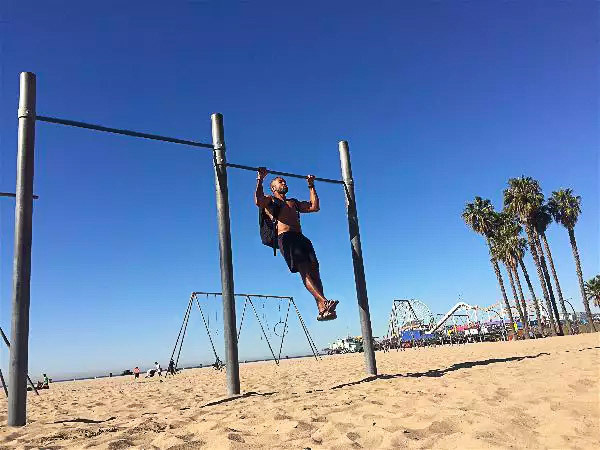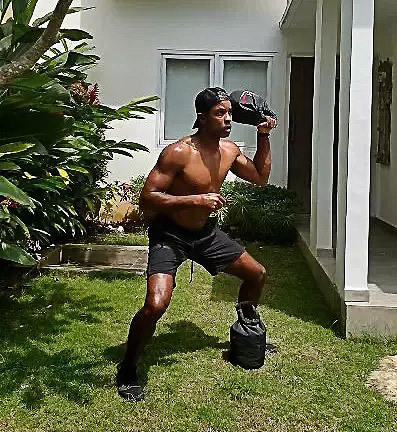
During this “stay at home” period, while we’re all responsibly doing our best to help flatten the curve, we can’t slack on fitness. A robust, healthy body is essential to an active life and a cheap insurance policy against injury and sickness. Something so beneficial deserves the worthy effort and time, even with no gym in sight and no road to ruck on. No compromise.
With a good rucksack, a few extra tools, and a “workout anywhere” mindset, a solid workout is possible anytime, any place giving you a way to stay healthy while briefly escaping the moment by moving your body.
Over the last three years, I’ve kept this “stay fit anywhere” idea top of mind during my travels around the world, continually diving, surfing, trekking, and motorbiking through the far-off corners of the world. Because each destination and adventure had unique physical demands, staying fit, and knowing how to train consistently without a gym, was necessary to match the physical challenges and thoroughly enjoy every experience that came my way. From Southeast Asian motorbike rides to deserts of the Middle East between Bedouin camps, the seven fitness ideas that follow served me well in cultivating stamina and strength while training anywhere.
During this time of isolation, while we’re all eager to stretch our legs but more pressed to do our part, these ideas will work for you too. While we’re all staying at home to help “flatten the curve,” use these seven ideas to stay strong, stay fit, and #KeepTraining for that next adventure.
7 Ideas for How to Keep Training Anywhere
- If you can’t ruck, lunge with your ruck.
- Pair your ruck with high-intensity calisthenics for a functional, strength-building workout.
- Add a suspension trainer for upper body resistance training.
- Use your ruck as a kettlebell to unlock new movements and workouts.
- Use Tabata protocol workouts for quick, intense cardio in a small space.
- “Grease the groove” to break the day’s monotony and build strength.
- Focus on mobility by stretching in the downtime and between workout days.

1. If you can’t ruck, lunge with your ruck
The low speed, high burn movement of lunging develops the same muscles of the legs and glutes as rucking while conditioning for more strength, more range of motion, and endurance under heavy loads. Pump up the intensity by pairing the classic movement with your ruck to make the most of leg workouts in small spaces.
Lunging is not only an excellent complement to rucking but is also a great way to keep your legs strong and ruck ready with limited space.
How to Execute: Perform 25 walking lunges on each leg or lunge 50 meters per set. Rest 2 minutes between sets or until your heart rate slows, then get after it again for five sets total. Aim for 10 sets if you’re feeling like a champ.
Increase the Intensity: Add a “high step” to the end of each lunge, rising onto the tiptoe of your rear leg while bringing the opposite knee to waist level at the end of each lunge, then continuing.

2. Do calisthenics with your ruck on
Calisthenics and bodyweight exercises are excellent for endurance but often lack the resistance necessary to build and maintain ample strength.
To replace your gym completely while still continuing to develop strength, perform calisthenics with a ruck on your back to achieve upper body strength and muscle building exercises. Pull-ups, push-ups, squats, dips, suspension training rows and presses, “man-makers”, and burpees (replacing the hop with a squat) are all excellent exercise candidates.
How to Execute: Aim for smooth, controlled movements in all exercises. Perform your regular calisthenics routine while wearing a well-secured ruck with weight or “grease the groove” accumulating sets throughout the day.
Increasing the Intensity: Use weighted calisthenic movements in a full high-intensity interval training (HIIT) workout that only uses calisthenics normally.

3. Add a suspension trainer to enable upper body resistance training anywhere
Getting an excellent upper body workout without a gym or standard weights can seem difficult at first.
Adding a compact, versatile suspension trainer to your fitness kit can fix this problem quickly making a full range of upper body possible: pulling movements, such as pull-ups and rows, and pushing movements, such as dips and overhead presses, are all possible with the extra resistance available from wearing your ruck.
How to Execute: My suspension trainer of choice is my DIY gymnastics rings set that doubles as a suspension trainer, sets up anywhere indoors or outdoors, and packs down to the size of a coffee mug. Better yet, building it takes less than 30 minutes and $30.
To use, simply setup in a doorway, on a tree or pole, or on a pull-up (as you would gymnastics rings) and recreate any movement you may do with a pull-up bar, dip bar, or even Olympic bar.
Increasing the Intensity: Put on your ruck to add extra resistance to the movements.
4. Use your ruck as a kettlebell
Kettlebell exercises are some of the most practical and functional exercises around, with thousands of great kettlebell workouts already available freely online that can be done in a single, small room. Think of your ruck as a soft kettlebell and open up a whole new way to train in confined spaces.
How to Execute: Get a ruck with handles on at least two sides. I highly recommend the GORUCK Rucker (my workout bag of choice) as it excels in improvised kettlebell workouts. Then, pack your weight securely, with as little potential shifting as possible.
Start with the basic kettlebell movements and learn to adapt them for execution with your ruck. I recommend beginning with the kettlebell swing, high pull, deadlift, Turkish get-up, overhead press/push press and bent over rows.
Increasing the Intensity: At the end of workouts, go for 100 “ruck swings” (similar to kettlebell swings) as a smoker or do the aptly named “kettlehell” workout on its own for a full workout.

5. Use the Tabata protocol for quick, intense cardio workouts in a small space
This eight-round, four-minute, and thirty-second long workout template is high intensity and arguably the fastest way to a great cardio workout done, indoors or outdoors.
How to Execute: First, pick any medium to high-intensity exercise – my favorite is the burpee, but squats and push-ups work just as well. Then, perform 8 rounds of 20 seconds each for your chosen exercise at maximum tempo followed by 10 seconds of rest between 20-second rounds, repeating the same exercise for all 8 rounds.
This is an excellent “smoker” workout, great as a cardio finish to strength-focused and HIIT training.
Increasing the Intensity: Do three Tabata workouts of eight rounds each back to back with a minute rest in between. For each 8 round set, dedicate one each to pull-ups, push-ups, and squats

6. “Grease the groove” throughout the day to break up the monotony with small sets of exercises, building strength along the way
One of the hardest parts of staying at home, or in any confined space, is the monotony. Break up that boredom by performing your exercise of choice – pull-ups, push-ups, pistols, etc. – in single sets of low repetitions several times throughout the day.
This approach of engaging muscles in small spouts repeatedly over long periods conditions neurological pathways between the brain and the muscle group to increase strength in specific movements and muscle groups, without ever reaching exhaustion.
The results are a less monotonous day, stronger muscles, more skill in movements, and no recovery time.
How to Execute: Pick an exercise each day and a number of reps per set – ideally half your max. Perform a set every hour, on the hour. Pull-ups, dips, push-ups, squats, handstand push-ups, handstands (for time) and “ruck swings” (kettlebell swings with a ruck) are excellent options.
Aim for smooth, controlled movements and perfect form on every single rep.
Increasing the Intensity: Incorporate higher intensity exercises and movements, such as handstand push up progressions, one-armed push-up progressions, and single-legged squats.

7. Improve mobility by stretching in downtime and on off days
We can’t constantly exercise through these periods of isolation, but we can theoretically recover and improve throughout the entire period.
Proper stretching and mobility training can undo past damage and kickstart healing of nagging injuries during our relaxed time at home, making this an excellent option for your “stay at home” training routine.
How to Execute: Pick the body parts or joints that are the stiffest and nag you the most. Then, do some quick research to find two stretches or mobility drills for your target body part/issue.
Once you have your specific stretches and drills, dedicate, 2 minutes to stretching each side. In the stretch, go deeper gradually and carefully as you feel the muscle release.
If you don’t know where to start, begin with the hips, lower legs (calves and ankles), or shoulders. If you’re a desk warrior, add forearms and elbows as a starting point.
Increasing the intensity: “Grease the groove” with stretching and make it an all-day affair. Once you’ve picked your nagging joint or stiff body part, stretch for one to two minutes every hour throughout the day for continuous improvement.
Get the Right Gear for Great Workouts at Home
No matter where I’m at in the world or what adventure I’m on, fitness and good health are paramount, and this still applies even with no gym in sight. To eliminate any excuses, I bring my fitness essentials everywhere and use them everywhere, to stay ready, anywhere.
Here are the essentials pieces of gear I recommend adding to your fitness kit:
- A solid ruck, with handles: The GORUCK Rucker is my weighted workout backpack of choice, but any heavy-duty bag with two handles will do.
- A soft, adaptable, travel-friendly weight: Collapsible/reusable sandbags are my favorite because they’re travel-friendly (simply empty and refill at your destination) and a soft weight perfect for weighted calisthenics and dynamic movements.
- A compact, versatile suspension trainer: The DIY gymnastics rings mentioned above can be made in 30 minutes for less than $30 and allow me to do every upper body movement necessary for well-rounded fitness. They also double as gymnastics rings if a pull-up bar is available as an anchor.
- A good set of kicks: Whether for rucking, burpee Tabatas in the garage, or the exploration that fitness enables, a good set of footwear makes a world of difference. The uber-lightweight GORUCK MACV-1 has doubled as a great travel boot, and the versatile GORUCK I/O Trainer is an excellent travel shoe option as well as a solid trainer.
No matter what your location or situation is, fitness is an asset and something we should consistently invest in accordingly. With the ideas above, you’ll be ready to get after it anywhere, so keep training.
About the Author
Carlos Grider is a U.S. Marine Corps veteran who is currently quarantined in Bali. You can find him writing about travel and fitness here.
Featured Gear:
